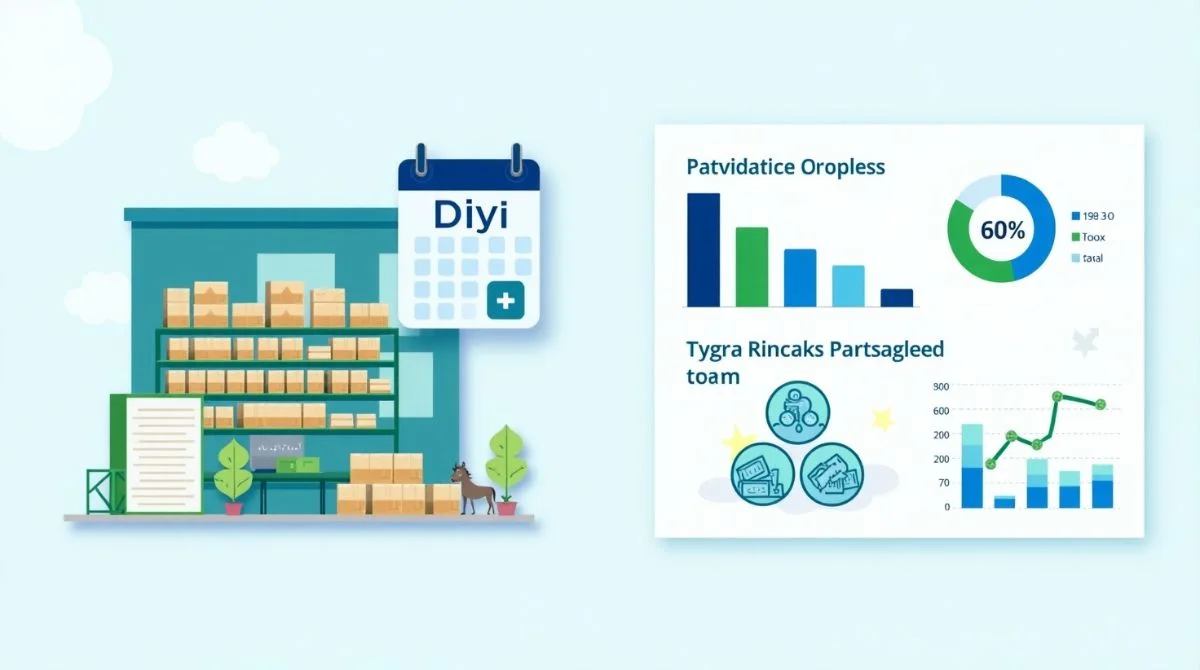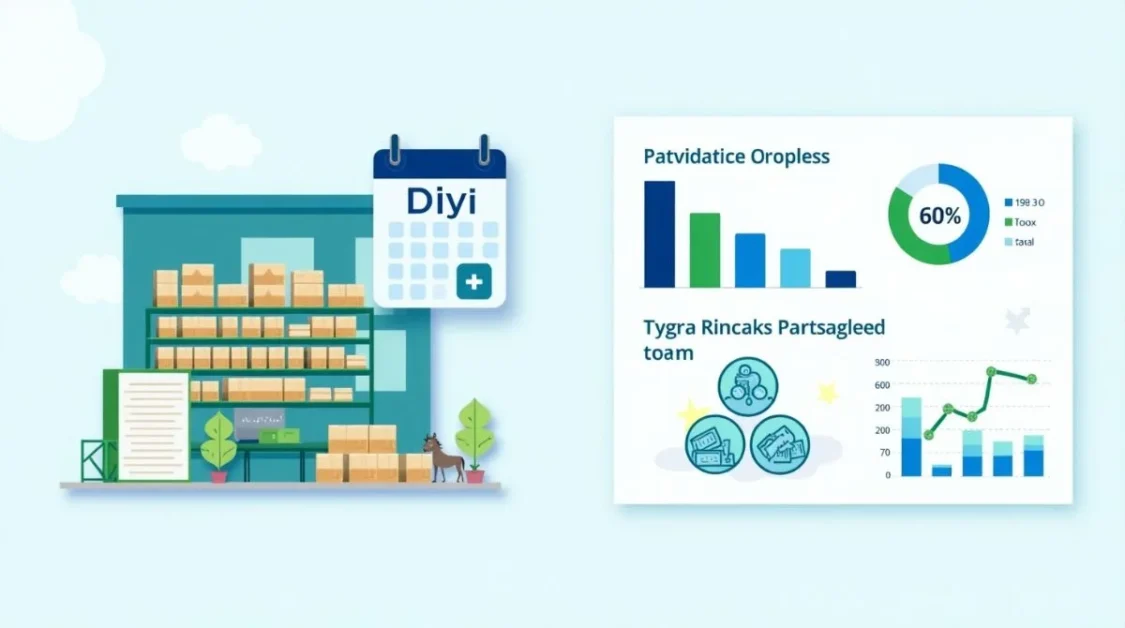Days Inventory Outstanding (DIO)
It is a financial performance metric that measures the average number of days a company holds inventory before selling it. It reflects how efficiently a company manages its inventory and converts it into sales. A lower DIO indicates faster inventory turnover and better operational efficiency, while a higher DIO may suggest overstocking, slower-moving goods, or inefficiencies in the sales process.
DIO is a component of the Cash Conversion Cycle (CCC) and helps businesses understand how long their capital is tied up in inventory. It is calculated using the formula:
DIO = (Average Inventory / Cost of Goods Sold) × Number of Days
DIO Formula
The Days Inventory Outstanding (DIO) formula helps businesses measure how long it takes, on average, to sell their entire inventory during a specific period. It shows how efficiently a company manages its stock and is crucial for understanding operational performance.
The standard formula is:
DIO = (Average Inventory ÷ Cost of Goods Sold) × Number of Days
Average Inventory = (Beginning Inventory + Ending Inventory) ÷ 2
Cost of Goods Sold (COGS) = The total cost of producing or purchasing the goods that were sold during the period
Number of Days = Typically 365 for a full year
This formula tells you how many days’ inventory sits in storage before it’s sold. A lower DIO means faster turnover, indicating strong sales or efficient inventory management. A higher DIO might suggest slow-moving stock or over-purchasing, which can tie up capital and increase storage costs.
For example, if a company has an average inventory of $50,000 and annual COGS of $300,000:
DIO = ($50,000 ÷ $300,000) × 365 = 60.83 days
This means it takes about 61 days to sell through the average inventory. Companies monitor DIO closely to balance product availability and cash flow.
What Is Inventory Turnover?
Inventory Turnover is a ratio that shows how many times a company sells and replaces its inventory over a given period, usually a year. A high inventory turnover indicates that a company is efficiently managing its stock and selling products quickly. Conversely, a low turnover suggests excess inventory, weak sales, or poor inventory planning.
Formula: Inventory Turnover = Cost of Goods Sold (COGS) ÷ Average Inventory
This metric is useful for evaluating performance across different periods, product lines, or industry benchmarks. It reflects the velocity of inventory movement.
How Are They Related?
Inventory Turnover and DIO are mathematically linked. When Inventory Turnover increases, DIO decreases, and vice versa. They provide the same core insight but in different formats: one in frequency (turnover), the other in time (days).
Relationship: DIO = 365 ÷ Inventory Turnover
This connection allows businesses to toggle between the two depending on the type of analysis or presentation required.
Uses Each Metric
Use Inventory Turnover when comparing sales performance or efficiency across different companies, product lines, or timeframes. Use DIO when analyzing cash flow, operational cycle length, or how long inventory is tying up working capital. Both should be monitored together for a complete picture. A high Inventory Turnover with a low DIO indicates optimal inventory health.
Why is Days Inventory Outstanding (DIO) Important?
In the world of business and finance, understanding how efficiently a company manages its inventory is crucial to long-term success. That’s where Days Inventory Outstanding (DIO) becomes an essential metric. It doesn’t just reflect how long goods sit on a shelf, it tells a much bigger story about operational efficiency, cash flow, and overall profitability.
1. DIO and Cash Flow Management
One of the primary reasons DIO is important is its direct impact on cash flow. The longer inventory remains unsold, the more capital is tied up in stock. This affects liquidity, which is the company’s ability to pay bills, invest in new opportunities, or respond to market changes. A high DIO means more money is trapped in unsold goods, whereas a low DIO means the company can quickly convert inventory into cash.
For example, if Company A has a DIO of 90 days and Company B has a DIO of 30 days, Company B is freeing up cash 60 days faster. That’s a big advantage in competitive industries.
2. Operational Efficiency
DIO also reveals how well a company manages its inventory operations. A consistently high DIO might suggest problems like overstocking, inaccurate demand forecasting, or slow-moving products. These issues can lead to increased storage costs, product obsolescence, or even waste, especially in industries like fashion, electronics, or food, where items lose value quickly.
By contrast, a low DIO suggests a company is operating efficiently: ordering the right amount of stock, minimizing holding costs, and responding quickly to customer demand.
3. Profitability and Margins
Inventory management directly affects a company’s gross margin and profitability. Excess inventory can result in markdowns or clearance sales, cutting into profits. Holding inventory for long periods may also lead to damaged or outdated goods. All of these reduce the overall return on investment (ROI).
Monitoring DIO helps managers spot these inefficiencies early. By improving turnover speed, companies can increase profit margins while reducing unnecessary costs.
4. Decision-Making and Planning
DIO serves as a key input in strategic business decisions. For example, companies use DIO when:
- Setting reorder levels and restocking schedules
- Forecasting future sales and planning promotions
- Evaluating supplier performance and lead times
- Benchmarking performance against industry standards
Investors and financial analysts also pay close attention to DIO when assessing a company’s operational health. A sudden change in DIO could signal upcoming risks, such as slowing demand or production issues.
5. Benchmarking and Industry Comparisons
Different industries have different average DIO values. A grocery store might have a DIO of just a few days, while a car manufacturer may have a DIO of 60–90 days due to the complexity of its inventory. Comparing a company’s DIO to industry averages helps assess whether it’s leading or lagging in inventory efficiency.
Factors That Affect Days Inventory Outstanding
Days Inventory Outstanding (DIO) can vary widely depending on several internal and external factors. Understanding these influences helps businesses manage inventory more effectively and improve overall efficiency.
1. Industry Type
Different industries naturally have different inventory cycles. For example, grocery stores and fast fashion brands aim for very low DIO due to perishable or seasonal products, while heavy manufacturing or luxury goods may have higher DIO because of longer production and sales cycles.
2. Inventory Management Practices
Efficient inventory systems like just-in-time (JIT) inventory or automated tracking can reduce holding time and lower DIO. Poor inventory planning, on the other hand, leads to overstocking and slow turnover.
3. Demand Forecasting Accuracy
Accurate demand forecasting allows companies to stock the right amount of inventory. Overestimating demand leads to excess inventory, increasing DIO, while underestimating it could cause stockouts and missed sales.
4. Supplier Lead Time
The time it takes for suppliers to deliver inventory impacts how much stock a company holds. Long or inconsistent lead times often lead to higher inventory buffers and, therefore, a higher DIO.
5. Seasonality and Promotions
Businesses with seasonal demand may experience fluctuating DIO throughout the year. Promotional events can temporarily speed up inventory turnover, reducing DIO during peak periods.
How to Improve Days Inventory Outstanding (DIO)?
Improving Days Inventory Outstanding (DIO) means reducing the average time inventory sits before being sold. This boosts cash flow, reduces holding costs, and increases operational efficiency. Here are some effective strategies:
1. Optimize Inventory Levels
Avoid overstocking by maintaining inventory that closely matches demand. Use data-driven forecasting tools to predict sales accurately and adjust orders accordingly.
2. Implement Just-In-Time (JIT) Inventory
JIT systems minimize inventory by receiving goods only when needed for production or sales. This reduces storage time and lowers DIO significantly.
3. Enhance Demand Forecasting
Leverage historical sales data, market trends, and seasonal patterns to improve forecast accuracy. Better forecasts mean fewer excess goods and faster turnover.
4. Streamline Supply Chain and Supplier Relationships
Work closely with suppliers to reduce lead times and increase delivery reliability. Faster replenishment cycles mean less need to hold excess inventory.
5. Promote Slow-Moving Inventory
Use discounts, promotions, or bundles to move slow-selling products faster. This helps free up space and capital tied up in stagnant inventory.
6. Regularly Review and Analyze Inventory
Monitor inventory metrics frequently to spot trends or issues early. Use this insight to adjust purchasing, production, or sales strategies proactively.
DIO vs. Related Metrics: Key Differences
Understanding DIO is easier when compared with other inventory metrics.
| Metric | Focus |
| Days Inventory Outstanding | Inventory to sales (in days) |
| Inventory Turnover Ratio | Number of times inventory is sold per year |
| Days Sales Outstanding | Time to collect payment after a sale (receivables) |
| Days Payable Outstanding | Time to pay suppliers |
Impact of Days Inventory Outstanding on Cash Flow and Profitability
Days Inventory Outstanding has a direct impact on a company’s cash flow and profitability, two critical aspects of financial health.
1. How DIO Affects Cash Flow?
When inventory stays on shelves for a long time (a high DIO), the company’s money is tied up in unsold goods. This means less cash is available for daily operations, such as paying bills, salaries, or investing in growth opportunities.
For example, imagine a business that spends $100,000 buying inventory but only sells it after 90 days. That $100,000 is locked in the warehouse, unable to generate revenue or cover expenses. On the other hand, a company with a DIO of 30 days frees up cash faster and can reinvest it sooner.
2. Profitability Considerations
Slow-moving inventory can lead to markdowns, discounts, or even waste, especially for perishable or seasonal products. These situations reduce profit margins and sometimes result in losses.
A lower DIO usually means:
- Faster turnover of goods
- Reduced storage and holding costs
- Less risk of obsolescence or damage
- Conversely, a high DIO might signal inefficiencies that erode profits.
3. Real-World Example
Take a fashion retailer holding inventory for 120 days compared to a competitor turning inventory every 45 days. The faster-turning retailer will generally have healthier cash flow and higher profitability, assuming sales volumes are similar.
4. Bottom Line
Managing DIO effectively means not only improving operational efficiency but also safeguarding the company’s financial stability. That’s why finance teams and managers pay close attention to this metric and seek continuous improvement.
How to Use Days Inventory Outstanding for Better Business Decisions?
Understanding DIO is just the first step. The real value comes from applying it to make smarter business decisions.
- Inventory Management
- By monitoring DIO regularly, companies can:
- Identify slow-moving products early
- Adjust purchasing schedules to avoid overstock
- Optimize warehouse space usage
For example, if a specific product category’s DIO spikes, it might be time to run promotions or adjust pricing.
1. Strategic Planning
DIO insights help in forecasting demand and production. Companies can plan inventory purchases more accurately, reducing the risk of stockouts or excess inventory.
2. Pricing and Sales Strategies
High DIO may push businesses to:
- Offer discounts on stagnant products
- Bundle items to move inventory faster
- Reevaluate marketing campaigns to boost sales
3. Investment and Valuation
Investors analyze DIO to assess how well a company manages its inventory relative to peers. A company with improving DIO trends might be more attractive due to better operational efficiency.
4. Using Technology to Monitor DIO
Modern inventory management software can track DIO in real time, providing actionable alerts and reports. This allows companies to react quickly to changes and maintain optimal inventory levels.
Conclusion
Days Inventory Outstanding (DIO) is a vital metric that reveals how efficiently a company manages its inventory. By understanding and monitoring DIO, businesses can improve cash flow, reduce holding costs, and enhance profitability. Whether you are a business owner, investor, or student, mastering this metric offers valuable insights into operational performance. Remember, the ideal DIO varies by industry, so always compare within the same sector. Use the strategies outlined here to optimize inventory turnover and make smarter, data-driven decisions that keep your business competitive and financially healthy. Start tracking your DIO today to unlock better inventory control and financial success.










